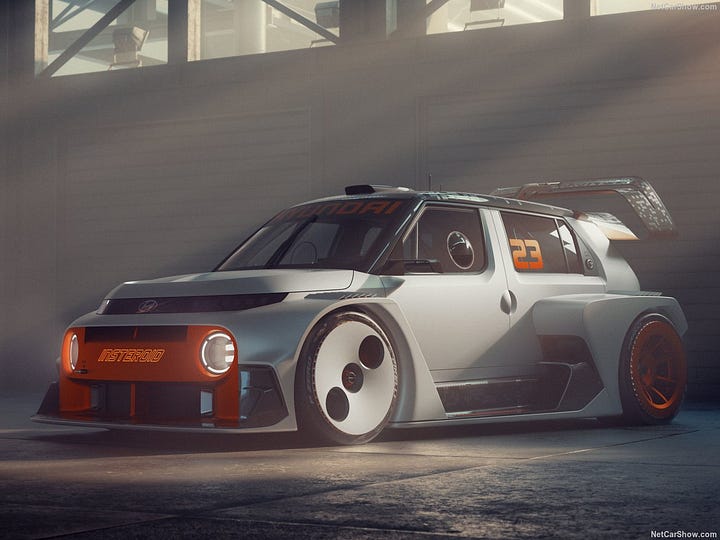Gamer-car (tomorrow's sports-car)
Once the car on a circuit or rally stage was, more or less, the one you could buy. Now this is returning, 21st century style; the car you drive in a game being, more or less, the one you can buy.
Not long ago in Europe most mainstream cars had a ‘hot’ version — the Peugeot 205 GTi, BMW M3, Ford Cosworth — most being linked to rally cars and track race cars that they appeared to share much with. You saw them on rally stages one day, in the supermarket carpark the next — and this proximity between ordinary and the heroically special made performance feel accessible for anyone with a car and a dream.
Then, as racing lost its marketing clout and performance cars became more commodified, the link between race-car fantasy and on-road special versions faded, body kits waned, and motorsport graphics became (whisper it) unfashionable. At the same time the growth in driving games and the importance of brands being represented in them became recognised, and for the last fifteen years or so brands have created digital designs for driving games such as Gran-turismo, and presented them as one-off concepts at shows.
Now though, that simple connection of everyday car to special hero of a car is quietly returning, just as we are seeing a new connection from driving game to car design. And this is both a global phenomenon that speaks to a new generation of customer, as well as a design trend where the ‘hot’ version of a car that no longer steps from the race-track.


In China, versions of mainstream sedans are appearing with extreme gamer-inspired exaggerated design graphics and spoilers — notably the BYD L Gamer Edition, GAC Hyptec GT, and Denza Z9GT presented at the recent Shanghai Auto Show. They don't focus on tangible performance gains or make direct motor-sport design references, but lean on a new form of more abstracted sense of performance and energy through connections with popular shows and gaming culture. They might seem slightly absurd, but they perform a role by making relatively mainstream vehicles feel charged with new expressive identities that stand on the shoulders of gamer culture.
Outside of China two similar but slightly different examples of this new form of everyday hero are evident in the Renault 5 Turbo and the Hyundai Insteroid concept. These pugnacious designs step from existing small production cars to be extravert expressions of this new form of 'hot' version of a standard car — the 'gamer-car'. Of the Insteroid, Hyundai describe it as seeking to “redefine what a sporty EV can be …. with gaming-inspired features”, their SVP of Design, Simon Loasby, saying that it is “a concept that invites everyone to dream a little louder and smile a little longer”. Renault describe the 2022 Renault 5 Turbo 3E concept (the progenitor of the 3E), as “a work of art with exaggerated lines, inspired by the videogame universe.” Like the Chinese designs these two also extend from gamer-culture more than motorsport, but do so with more features and more worked over interior designs — not just exterior graphics and appendages — to reach a more extreme and complete picture of the ‘gamer-car’.


And if the 'gamer-car' is the new sports-car then it also reflects a generational shift; younger car customers raised on e-sports and digital aesthetics respond more to visual attitude than drivetrain specifications, and value more how design realises the world-of-fast than they do about actual speed. The gamer-car also reflects a changing role for exterior design in the EV age: with similar driving experience and performance, design is increasingly THE central attribute shaping the identity of the car.


So the exciting 'hot' version of tomorrow's EV instead of looking akin to a race car as seen on TV speaks to the games being played on a variety of devices. Tomorrow’s sports-cars may likely increasingly be ‘gamer-cars’.




Fascinating perspective: thanks for the insight! Be interesting to see some of those editions spread beyond China.